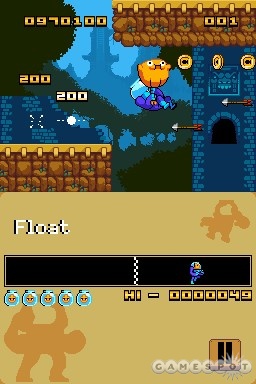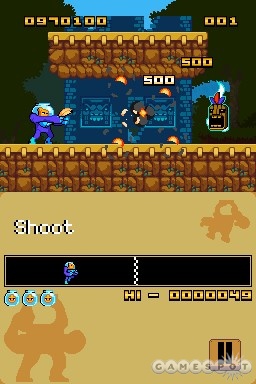It's not often a child goes on a quest to rescue his goldfish, much less the other way around. The original Flipper for DSiWare was about the former; Flipper 2 throws the titular goldfish Flush into a robot suit (reminiscent of the suit worn by Earthworm Jim) and has him saving his owner. This is done by making your way through castles filled with traps and monsters using a single button. In this way, Flush the Goldfish mixes the popular one-button simplicity of recent mobile hits like Jetpack Joyride with some of the crazy randomness of WarioWare, but unfortunately, the result isn't quite as addictive or entertaining as the games that inspired it.

Every action in Flush the Goldfish is controlled by pressing, holding, or tapping the A button. Which action the button performs changes with every single-screen room you enter as you play. In one room, the A button command may be "stop," and you need to press it at the right moments to avoid being impaled by spikes or crushed by rocks. In the next room, you may need to hold the button down to charge a jump, which you need to time right to avoid deadly pitfalls. Each room typically lasts a few seconds at most and sees you running, ducking, shooting, and even slapping your way to the goal. Levels are made up of a collection of rooms with a few checkpoints. If you die, you are dropped right back to the start of the room until you run out of lives, at which point you are taken back to the last checkpoint you passed.
The story mode, which barely contains any semblance of a story at all, can be completed in half an hour or less unless you struggle with some of the stages. It is split up into four levels across four different environments and ramps up in difficulty as you progress. When you start out, there's some excitement in the discovery of new actions, and challenge in learning how to use them before you are killed. Rooms often start with Flush already moving to the right toward danger, so you have to be quick on your feet to get around obstacles. The problem is that there's not enough variety in what you're doing, and by the end of the short story mode, you will quite possibly have had your fill. Once you know what each action does and you can anticipate the different types of challenges thrown at you, the gameplay becomes painfully rote. Another problem lies in the difficulty that some harder stages can present, which makes the game more frustrating than challenging. These stages tend to require very precise timing that you can master only through trial and error, which becomes a pain if you run out of lives and lose progress.
The story mode is short, but at least there's a bit more content to experiment with when it's done. Finishing the story unlocks the ability to play randomized levels consisting of a selection of more than 300 rooms, giving you options for which environment type you want and whether you want easy, medium, hard, or a mix of difficulty. In theory, this could supply plenty of replay value, but even with a random set of levels, you run into the same issue of repetition as in the story mode. When playing either mode you are encouraged to grab coins scattered throughout each screen, which raise your overall score. Unfortunately, the game lacks even a local leaderboard, instead opting to display only the single highest score in each mode on the title screen. It doesn't give you much incentive to strive for more points.

After you complete at least one randomized set of rooms, you unlock a level editor, which lets you create your own rooms to play through. This feature has potential, but it's significantly flawed for two reasons. First, there are only three slots on which to create single-room stages, and there is no way to string them together into a full set. So you make a stage, play it for the couple of seconds that it lasts, and that's it. Furthermore, there is currently no way to share levels with friends, despite a menu option that gives you a generated code and states, "This code might come in handy in the future!" which seems to indicate that an update or sequel is coming. You're also limited when designing levels because you have only a maximum of 16 sprites to work with. To top it all off, there is no option to design levels with the touch screen (which seems like it would be a natural fit), meaning you must use the D-pad and buttons. This method is functional but slow.
Flush the Goldfish starts off favorably, with a fun premise, nice retro-style art, and a promise of addictive, simple gameplay. But it never quite nails that "addictive" part, and in the end it fails to provide a reason to keep coming back. It's fun for a little bit, but not so fun as to justify its 500 point ($5) price tag. It's worth a try if you're looking for a cheap game to keep on your DS for very short, infrequent bursts, but don't go in expecting hours of variety.